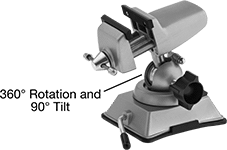Filter by
Mount Type
Vise Type
Jaw Texture
Jaw Style
Jaw Material
Overall Height
Body Material
Overall Length
DFARS Specialty Metals
Export Control Classification Number (ECCN)
Jaw Mounting Hole Center-to-Center
Jaw Mounting Screw Thread Size
REACH
RoHS
Tilt Range of Motion
Jaws Replaceable
Overall Width
Weight
Base Type
Tilting-Head Bench Vises
The head tilts, rotates, and locks in place to hold work at an angle.
Suction-mount vise attaches to smooth surfaces. Use the lever to engage and disengage the rubber suction pad.


























